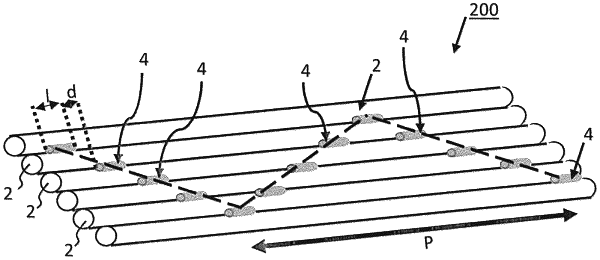| CPC G02B 6/4403 (2013.01) | 20 Claims |

|
1. An optical-fiber ribbon, comprising:
(i) a plurality of respectively adjacent optical fibers extending in a longitudinal direction and arranged in parallel to form an optical-fiber assembly, wherein each optical fiber includes, from its center to its periphery, a glass core, a glass cladding, a primary coating, and an outermost secondary coating comprising a cured first curable resin; and
(ii) a plurality of successive elongated rectilinear beads comprising a cured second curable resin arranged along the optical-fiber assembly, wherein the beads are configured to form elongated bonds between adjacent optical fibers in the optical-fiber assembly;
wherein, as measured by a T-peel test, the force required to separate one optical fiber from the optical-fiber ribbon is between 0.01 N and 0.2 N; and
wherein, along at least a portion of the optical-fiber ribbon that includes one or more elongated rectilinear beads, each bead is configured so that when removing an optical fiber during optical-fiber breakout the corresponding point of failure occurs (i) within the bead without damaging the optical fiber's primary coating and/or the optical fiber's outermost secondary coating, and/or (ii) at the interface between the bead and the outermost secondary coating without damaging the optical fiber's primary coating and/or the optical fiber's outermost secondary coating.
|